Collecting Antiquities
written by Joanna van der Lande
Ancient Greek bronze sculpture, 2000 years old Roman marble bust or maybe a turquoise scarab amulet straight from an ancient Egyptian tomb? Although in general those things belong in the museums, the collector's market for antiquities is growing and is as fascinating as ever. Who would not love to have a piece of ancient history in their collection! Read our Antiquities Expert explaining the joys and hardships of collecting ancient artefacts.
Four Greek terracotta male heads, Taranto, circa 4th Century B.C., 6cm – 11cm high. Sold for £6,200 hammer price. Courtesy of Bonhams
Few people are fortunate enough to spend their working life pursuing their interests. For over 30 years, I’ve been handling objects crafted by our distant ancestors, which has been an immense privilege. After a few years studying ancient history and archaeology at university, it took a spell working on the main reception at what was the original Phillips HQ in Woodstock Street, London (now a side entrance to Bonhams New Bond Street), to realise that people actually collected ancient artefacts. There has of course been a long history of collecting ancient artefacts, but this was not something taught on a university archaeology course where any mention of collecting artefacts was somewhat frowned upon.
By conducting a basic Google search, you’ll find the subject of collecting antiquities shrouded in controversy. It shouldn’t take you long to establish that considerable care will need to be taken if you are to try and create a collection yourselves. Research and obtaining some knowledge are essential to any would-be collector.
Are you looking for Ancient Art Appraisal? Click Here!
What are Antiquities?
While similar principles and advice apply to the acquisition of all art, what I will refer to, in this article, relates specifically to ancient artefacts. Though millions of artefacts survive from ancient cultures geographically spanning the Americas to Southeast Asia and Australasia, the art market defines the Antiquities market (often used interchangeably with the term Ancient Art), to include artefacts from north and western Europe, those countries once forming part of the Roman Empire, Egypt and the many Ancient Near Eastern cultures stretching as far east as Afghanistan, dating from prehistory to the Early Byzantine period. Art market disciplines selling other ancient artefacts tend to fall into the following categories: African, Oceanic and Pre-Columbian art/Ethnographic, Indian, Himalayan & Southeast Asian Art, Islamic & Indian Art. While coins are a separate discipline altogether. It’s worth bearing this in mind because when you research the antiquities market, you’ll find articles and reports referring to antiquities when in fact the journalist/blogger, academic and international laws, place all these categories under the single heading of ‘Antiquities’, which provide a somewhat distorted view of the Antiquities market.
"It cannot be stressed enough how important it is to do some background research prior to starting a collection and this takes time. Of course, you might be reading this article and be surprised to know you can buy these artefacts at all, and just want to get on with it and not wait years before you buy your first antiquity."
How big is the Antiquities market?
In fact, the Antiquities market, as defined by the art trade, makes up only about 0.5% of the global art and antiques market, so we are talking about a very small and specialist area of collecting.

Seven miniature Greek pottery vessels and a Campanian terracotta gorgon mask. Circa 8th-4th Century B.C., 3cm – 12.3cm high, sold for £1,100 hammer. Courtesy of Bonhams
How can I start a collection of Antiquities?
It cannot be stressed enough how important it is to do some background research prior to starting a collection and this takes time. Of course, you might be reading this article and be surprised to know you can buy these artefacts at all, and just want to get on with it and not wait years before you buy your first antiquity. The best place to start is to approach antiquities dealers who are a member of a reputable trade association, or the Antiquities department of a well-established auction house. But you can’t escape the need to conduct some basic research before you start - which is half the fun of it.
Related: Learn About: Pre-Columbian Art
Are there restrictions in owning Antiquities in your country?
Some European and a number of other countries, either prohibit or restrict the ownership of antiquities, though many others do not. So, if you are based in Greece, for example, you may find the prohibitions too restrictive to want to embark on acquiring any antiquities from sale abroad. So, the first thing you should do prior to starting a collection, is to understand the laws on possessing ancient artefacts in your country of location. Do you have to obtain a permit or register your artefact with the authorities? Will you be able to re-export the artefact, perhaps to re-sell it or to take with you if you move abroad or back home, or is export or the ownership of antiquities completely prohibited?
"Never be afraid to contact the owner to ask them to confirm where they are selling from, where the items are located and discuss any export licence requirements. It is also a sad fact that many fake items are offered for sale, or items which cannot be legally traded, which is why it is so important to buy from a reputable dealer."
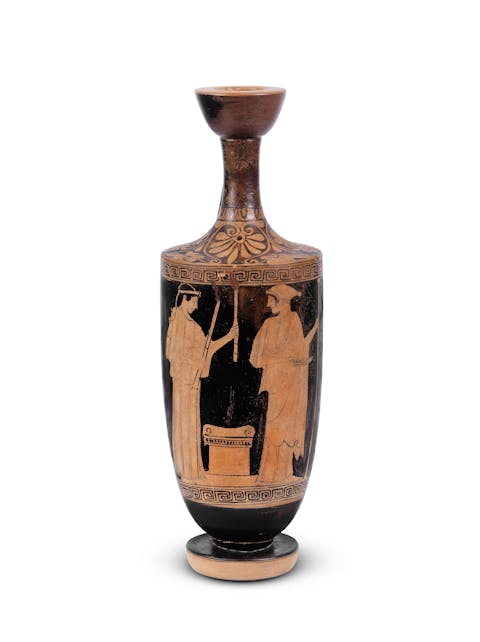
An Attic red-figure lekythos, attributed to the Painter of the Yale Lekythos, circa 480-460 B.C., 26.9cm high, sold for £5,000 hammer price. Courtesy of Bonhams
Where should I buy from and where should I avoid buying from?
Once you’ve established these basic practicalities, find reputable dealers and auction houses. While you may find some in your own country, you will find the majority of them in Austria, Belgium, France, Germany, the Netherlands, Spain, Switzerland, the UK and the US. Make sure the dealer is a member of a reputable trade association. Some auction houses are also members of trade associations while others are not, so it’s important to make sure they have a good track-record for selling antiquities. Nearly all dealers and auction houses have an online presence these days – it forms part of their shop window. There are many selling platforms and you’ll often see the same objects being offered on different platforms. Always check who is actually offering the artefacts for sale and check their credentials. Avoid buying anything via Facebook, who have banned the sale of artefacts. Ebay do have certain checks in place and a lot of individual sellers offer small items on eBay, but again you will need to check who is actually offering the artefacts for sale and find out what country they are located in. Never be afraid to contact the owner to ask them to confirm where they are selling from, where the items are located and discuss any export licence requirements. It is also a sad fact that many fake items are offered for sale, or items which cannot be legally traded, which is why it is so important to buy from a reputable dealer.
Related: Learn About Islamic, Indian, & Middle Eastern Art
What antiquities should I start buying?
First and foremost, what you like and can afford. You may be more attracted to Roman glass in all its forms and colours; or perhaps to Greek terracotta figurines, which you may find sculpturally as appealing as a marble of a similar size, while being more affordable. You may prefer the classic black- or red-figure pottery vessels depicting scenes of life from thousands of years ago, to the simpler decoration of a Cypriot Iron Age vessel. And yet, you may find the decoration of an Iron Age pottery vessel from Cyprus fits well into a 21st century setting. Egyptian antiquities are always popular. The material culture from that extraordinary civilisation with their love of animal gods, provides a huge variety of attractive and so often exquisitely made artefacts. Or you may prefer to collect artefacts from the many ancient civilisations that have populated the Middle East and Central Asia; or perhaps early Christian artefacts from Byzantium. Or you may be interested in Prehistoric artefacts, or artefacts from the European Iron Age or Viking Period. This list is far from exhaustive but just demonstrates the breadth of cultures and periods you could collect.
Whether your interest has been influenced by your ancestry, nationality, somewhere you once lived, a holiday, or just a fascination with humans’ ancient origins, or for whatever other reason, it doesn’t matter. What does matter is that you buy what appeals to you and that you buy responsibly.
"The beauty of collecting antiquities, is that you do not have to spend too much money to start collecting but my advice would be always to buy the best based on what you can afford."
Do I have to spend a lot of money to start a collection?
The beauty of collecting antiquities, is that you do not have to spend too much money to start collecting but my advice would be always to buy the best based on what you can afford. I will outline some collecting areas in the paragraphs below, which will provide you with some more in-depth information, though this will be a tiny fraction of the different categories of antiquities available on the market.
Roman Glass
While you might think this a rather alarming type of artefact to buy, due to its fragility, you might be surprised to know that millions of intact Roman glass vessels survive. What is wonderful about collecting Roman glass, are the variety of forms and the array of colours, both their natural colour and the iridescence caused by a chemical reaction when once buried. You can also buy some very pleasing low value Roman glass, so it’s a great way from which to start building a collection. A simple unguentarium can be bought from around £150, sometimes a little less. The most commonly found colour is a greenish blue, so these can be cheaper to buy, while richer colours add more of a premium, from cobalt blue, to deep amber, aubergines or even deep green or brighter blues and clear glass have a premium. To see a glass collector’s cabinet full of the wide variety of shapes and colours, is a pleasing sight. There are glass collecting societies, so you can learn and share knowledge with others as you develop your hobby.
Tips to watch out for: The value of Roman glass is affected by condition. Sometimes repairs can be covered by applied iridescence. Buy yourself a long light, which can fit inside even narrow-necked vessels that you’ll find helpful in illuminating any possible repairs.
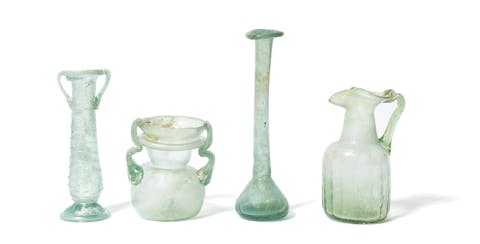
Four Roman green glass vessels, circa 2nd-6th Century A.D., 7.5-14.5cm high, sold for £650 hammer price. Courtesy of Bonhams

A Roman pale aubergine glass twin-handled jar, circa 3rd-4th Century A.D., 18cm high, sold for £1,500 hammer price. Courtesy of Bonhams
Greek terracotta figurines
The sculptural quality of small mould-made terracotta figure makes these, often miniature, Greek sculptures an appealing and generally cheaper alternative to marble. There are an immense variety of sculptural styles with stylistic variations due both to time and local variations, from mainland Greece to its myriad of Islands, as well as from the Greek colonies of Southern Italy. You can buy a very pleasing himation-clad female figure for between about £800 – 4,000. With terracotta heads of woman often displaying very exotic hairstyles and rivalling their marble counterparts with their more highly textured features. Figures were often broken in antiquity, so always check to see if the head on a figure is original, repaired or possibly from another figure. Depending on the size of the head, a head alone can be bought from as little as £120, or for larger examples in the £1000s.
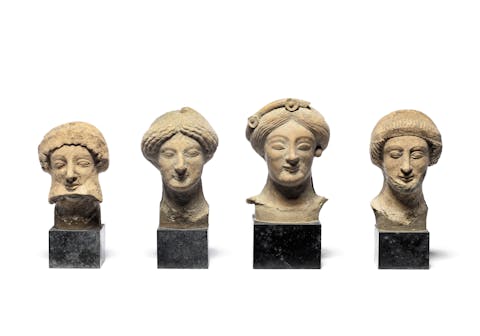
Four Greek terracotta heads, circa 5th Century B.C., 9.5 – 11.5cm high. Sold for £2,000 hammer price. Courtesy of Bonhams

Four Greek terracotta male heads, Taranto, circa 4th Century B.C., 6cm – 11cm high. Sold for £6,200 hammer price. Courtesy of Bonhams
If you like animals, you will find an imaginative variety in Greek culture, from monkeys to cockerels, horses and birds, with charming depictions of pigs, dogs and doves, to name but a few. If you wanted to extend your collection of animals, you would be richly rewarded if you turn your attention to Egyptian antiquities. They were a culture whose depths of imagination know no bounds, as demonstrated by their line-up of usually animal-headed deities.
Tips to watch out for: Repair and restoration; do all parts belong? Are all parts ancient? One simple test can help with terracotta artefacts and involves applying some water to the surface. If it emits an earthy smell and absorbs the water quickly, this is a good sign. For higher value terracotta and pottery items you can scientifically test when it was last fired. This is called thermoluminescence testing and is a well-regarded technique to establish age, when carried out by a respected laboratory.
Egyptian artefacts
The artefacts left to us by the Egyptian civilisation attest to their complex, imaginative, and in many ways, alien society, often leaving us in awe. The lengths they went to leaving monuments behind that to this day often have their original colour, and which appear to have been built for giants, can leave the humble visitor to Egypt lost for words.
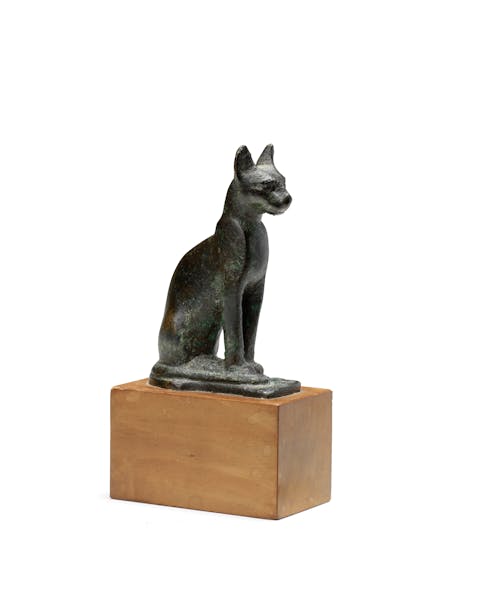
An Egyptian bronze cat, Late Dynastic Period, circa 664-332 B.C., 8.5cm high, sold for £2,800 hammer price. Courtesy of Bonhams
Many of you will have seen the artefacts from the tomb of Tutankhamun during its pre-pandemic tour. The quality, quantity, intricacy and sheer beauty of the objects cannot fail to leave an impression on the visitor. But what is astonishing is that so many ancient Egyptian artefacts are available to buy, with many of them of exquisite quality and often wonderfully coloured with bright blue and other glazes. There was a thriving antiquities market in Egypt up until 1983, at which point export was prohibited. A combination of the thriving trade and the system of partage – whereby an excavation sponsor, not always a museum, would split the finds between the Egyptian government and the sponsors of the dig, meant crate loads of artefacts left Egypt and found their way onto the international market.
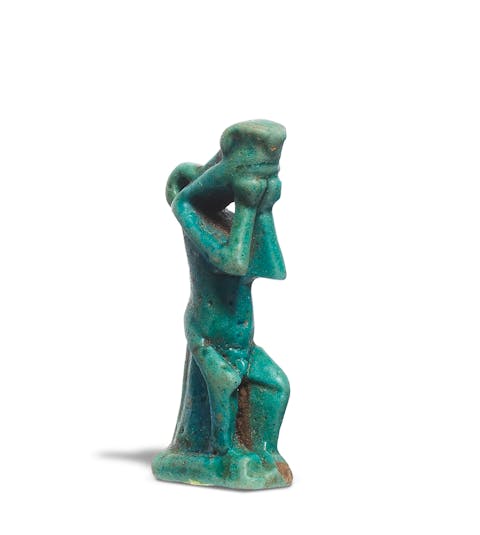
An Egyptian glazed faience amulet of snake-headed Nehebkau, Third Intermediate Period, circa 1069-664 B.C., 4.4cm high sold for £650 hammer price. Courtesy of Bonhams
What other types of artefacts can be collected?
Books have been filled with they wide variety of objects available to the collector. Many of which have been published by collectors, and have been included in exhibitions or museum displays. In this brief article I can only provide a small snapshot of the breadth of artefacts you could acquire.
If you have an interest in prehistoric artefacts, you will find Palaeolithic and Neolithic stone implements available, or Bronze Age, Iron Age or Early Medieval artefacts. In the UK and some other countries, it is possible to acquire locally found artefacts – some of which would be classified as ‘treasure’ and are therefore required to go through a legal process, which may or may not result in them being acquired by a museum. Here in the UK if they are disclaimed as treasure, the finder is free to sell them on the open market. The UK has a huge online database which has encouraged the reporting of all archaeological finds and provides a wonderful resource for research for a collector of British finds. While it is perfectly legal to sell and to buy such artefacts, if the finder had permission to detect on the land, when buying such artefacts, you will need to be mindful of export regulations and confirm this with the seller.
Check the latest Auctions with Ancient Art on Barnebys Here!
"The UK has a huge online database which has encouraged the reporting of all archaeological finds and provides a wonderful resource for research for a collector of British finds."
From the classical world, you will find bronze artefacts both figural and of a more mundane utilitarian nature, of various quality and sizes with some in both silver and gold. You will find many marble sculptures, including figures of just about every composition, or just heads, arms, legs, hands and feet. I’ve known people to just collect just feet for example! There are architectural elements, sarcophagi and cinerary urns, the list goes on.
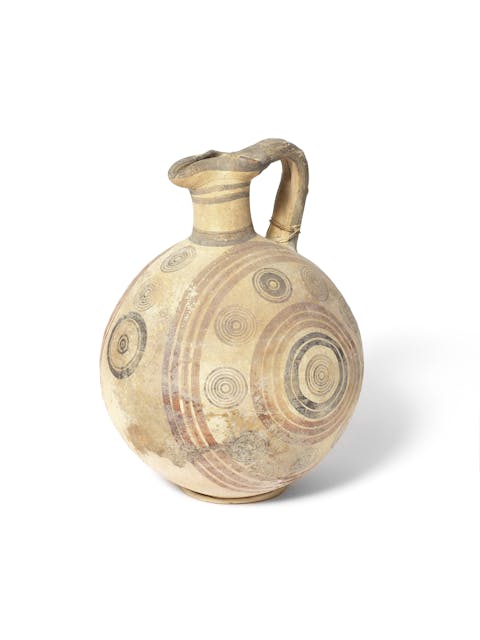
A Cypriot bichrome ware oinochoe, Iron Age, circa 750-600 B.C., 31cm high, sold for £2,000 hammer price. Courtesy of Bonhams
From the ancient near east, the many very ancient and highly sophisticated cultures from the geographic span of modern-day Turkey, Iran, Iraq and Syria to name just a few, have also left us with a breath-taking array of artefacts. There have been collectors of cylinder seals – some beautifully engraved with figures and ancient texts – which are absorbing enough to form a collection in their own right. They were rolled across the ‘envelope’ of a cuneiform tablet to confirm it had not been tampered with. Due to the upheaval of some countries in this region, additional caution needs to apply. The only country in the Middle East which continues to allow the controlled export of antiquities under a licensing scheme is Israel. Historically this was not always the case, with both the partage scheme in place and a thriving licit market which allowed for both the trading in and export of antiquities, in some countries until the latter half of the 20th Century. Lebanon, for example, allowed for the export of antiquities until 1988.
In Summary
Collecting Antiquities is uniquely rewarding, linking you in a chain of custodianship to our ancestors, and to future generations. They can be very affordable, starting from around £100 with some costing millions, though with many fine antiquities valued in the low thousands. With just a modest amount of research you will find there are many resources to help guide you on your collecting journey. Always try and buy the best example you can within your budget and never be afraid to ask about the ownership history. In fact, make sure you obtain a Certificate of Authenticity with each artefact you buy, with provenance information and keep all records, including any purchase invoice or shipping information in a file for future reference. Never be afraid to ask about condition. While these are ancient artefacts, many survive intact but others are repaired and restored. This can affect the value and any reputable dealer should inform you of condition prior to purchase. The auction houses tend not to print condition in their catalogues but will provide a written condition report on request – do not be shy about asking for one.
Above all, enjoy collecting antiquities. Your interest will link you to many an 18th or 19th century antiquarian, while it is worth remembering the ancient Romans were great collectors themselves.
Start your Ancient Art Appraisal Here!
Joanna van der Lande has been working in the art and auction business for over 30 years. She set up the Antiquities Department at Bonhams Auction house, London in 1990. She is an independent consultant providing valuations and advising on authenticity, provenance and political issues affecting the antiquities market, and is a valuer to the Treasure Valuation Committee, the Government body responsible for establishing the value of UK treasure finds. She regularly chairs vetting committees at London based art fairs.

